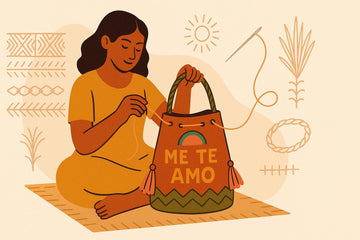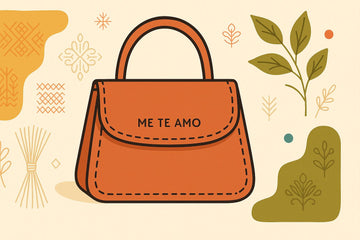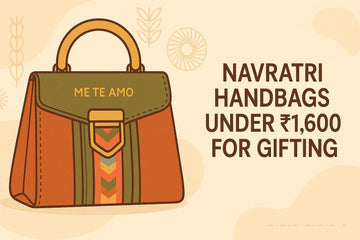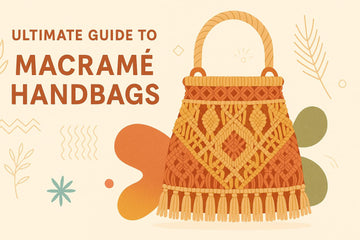Handmade vs. Mass-Produced: Why Women-Led Crafts Matter
by Medhansh Malhotra on Jul 09, 2025

Why do women-led handmade crafts matter in India? They combine quality, sustainability, and heritage preservation while empowering women and supporting rural economies. Handmade products, crafted with care and eco-conscious methods, stand out against mass-produced goods that often compromise individuality, ethical practices, and environmental care. Choosing these crafts uplifts women entrepreneurs, preserves India's rich artisanal traditions, and contributes to a greener future.
Key Highlights:
- Women in Crafts: Women make up 56% of artisans in India but manage only 14% of enterprises. Yet, their businesses deliver 35% higher ROI than male-led ones.
- Superior Quality: Handmade items feature better craftsmanship, durability, and unique designs compared to mass-produced goods.
- Sustainability: Handmade products use eco-conscious materials like natural fibres and recycled components, reducing waste and carbon footprints.
- Economic Impact: Women artisans gain financial independence, support local communities, and pass down generational skills.
- Cultural Heritage: Crafts like Kutch embroidery and Shibori dyeing preserve India's artisanal legacy, blending it with modern design for global appeal.
Quick Comparison:
| Aspect | Handmade Products | Mass-Produced Items |
|---|---|---|
| Material Quality | High-grade, eco-conscious | Synthetic, cost-focused |
| Craftsmanship | Personal care, unique designs | Machine-made, standardised |
| Durability | Decades or more | 5–10 years |
| Environmental Impact | Minimal | High resource consumption |
| Heritage Value | Preserves artisanal techniques | None |
| Community Impact | Empowers women, supports locals | Often exploitative |
| Price | Higher upfront, long-term value | Lower upfront, frequent replacement |
Conclusion: Opting for women-led handmade crafts isn’t just a purchase - it’s a choice to support quality, empower women, and preserve India’s artisanal heritage. Products like those from brands such as Me Te Amo prove that ethical, stylish, and eco-conscious fashion can be affordable and impactful.
Hand Made in India – Sustainability, Craft, Fashion | Radhi Parekh | TEDxNSSHillSpringIntlSchool
Handmade Products by Women Entrepreneurs: Quality and Impact
Women-led handmade crafts are more than just products - they’re a movement. They preserve heritage, transform communities, and bring meaningful value to modern markets. These ventures showcase how traditional skills can thrive while maintaining their essence.
Superior Craftsmanship and One-of-a-Kind Design
What sets women-led handmade products apart is the unmatched attention to detail and the personal touch each piece carries. Every creation reflects the artisan's individuality, resulting in subtle variations that make each item truly special.
"These textiles are more than just decorative pieces; they are symbols of identity, heritage, and empowerment." - Banjara Trail
Take the women of Kutch, for example. Their embroidery, patchwork, and applique work are not just crafts - they're legacies passed down through generations. This lineage ensures that every piece embodies centuries of refined artistry.
Unlike mass-produced goods, these artisans invest hours perfecting intricate designs. The result? Products that boast superior durability, thoughtful detailing, and a finish that speaks volumes about the pride of their makers.
Modern women-led brands are blending traditional craftsmanship with contemporary design, using digital platforms to reach global audiences. This fusion of old and new not only broadens their reach but also keeps age-old techniques relevant today.
And their commitment to quality doesn’t stop there - it extends to eco-conscious practices.
Eco-Friendly Materials and Production Methods
Sustainability is a cornerstone of women-led craft enterprises. These artisans often choose natural fibres like jacquard cotton blends, raffia, and vegan leather, pairing them with recycled polyester linings to create eco-conscious products.
Their production methods are equally thoughtful. Small-batch manufacturing significantly reduces waste, while techniques like low-waste cutting and paper-based packaging further minimise environmental impact.
"Shiro Mani isn't just a clothing brand...It's a celebration of Indian heritage - where every piece is inspired by traditional and tribal art, crafted with natural fabrics and chemical-free dyes." - shiromani.india
Chemical-free dyes and natural fabrics signal a return to traditional, sustainable methods. In Uttarakhand, for instance, women excel in Shibori, a Japanese resist-dyeing technique. The Mura Collective, known for its Shibori work, has even earned the UNESCO Seal of Excellence four times. Sourcing materials locally not only cuts down on transportation emissions but also supports a circular economy, benefiting entire communities.
But the impact of these practices goes beyond environmental benefits - they are also a pathway to women's economic empowerment.
Women's Economic Independence and Skill Development
The craftsmanship and sustainable practices behind handmade products don’t just set them apart - they also drive women's financial independence and strengthen community resilience.
For many women, handmade crafts are a lifeline to economic freedom. In 2015, Madhu Vaishnav’s Saheli Women in Bhikamkor, Rajasthan, revived traditional embroidery while creating health clinics, shops, and education initiatives. This empowered women like Valmiki to overcome societal barriers and thrive.
"Through our fashion partnerships we are able to keep our traditional crafts alive and preserve the cultural heritage that is deeply important to all our women and their communities." - Saheli Women
Skill development plays a crucial role too. In Naya village, Bengal, around 100 women are preserving their Pattachitra heritage, gaining recognition as artists. By keeping these traditions alive, they ensure their relevance for future generations.
Women-led craft enterprises often operate on collaborative models. Experienced artisans mentor newcomers, creating networks that foster knowledge-sharing and strengthen community ties. For instance, one brand exclusively works with women-led, small-batch manufacturers, ensuring fair wages, high-quality craftsmanship, and growth opportunities for its artisans.
"Our goal is to provide a space where women can shine, whether through our garments or within our team." - Sukalp Bhatija
The financial independence gained from these crafts allows women to make empowered choices about their lives, families, and education. This ripple effect often extends to community welfare, as women reinvest their earnings into education and development projects. Beyond economics, their art becomes a platform for storytelling, addressing issues like female infanticide and patriarchal challenges, turning their work into a powerful medium for social change.
Mass-Produced Items: Features and Drawbacks
Mass-produced items have become a cornerstone of modern markets, offering convenience and affordability. However, they come with notable compromises when compared to handmade alternatives. These trade-offs highlight the unique value of women-led crafts, setting the stage for a deeper comparison.
Standardised Design and Large-Scale Manufacturing
Mass production thrives on consistency, but this very strength often results in a lack of individuality. Items churned out by machines in vast quantities follow standardised designs, leaving little room for the unique charm or intricate detailing that handmade pieces offer. The emphasis on efficiency often translates into the use of cheaper materials, prioritising uniformity over personalisation. Unlike artisan creations, mass-produced goods lack the subtle imperfections and custom touches that make handcrafted items feel special.
This focus on large-scale manufacturing also brings along significant environmental and ethical concerns.
Environmental Impact and Ethical Issues
The environmental cost of mass production is staggering. It consumes immense natural resources, generates mountains of waste, and frequently relies on unethical labour practices. For instance, the fashion industry alone is responsible for 92 million tons of waste annually and contributes approximately 10% of global carbon emissions. The process is energy-intensive, often dependent on fossil fuels, and leads to water pollution and soil degradation.
On the ethical front, workers in mass production often face exploitative conditions, while consumers remain disconnected from the true cost of these goods.
"Buy less, choose well, make it last." - Vivienne Westwood
Handmade crafts, on the other hand, tend to have a smaller environmental footprint. They often use locally sourced materials, reduce transport emissions, and focus on creating durable products.
Missing Connection to Indian Heritage
Mass-produced goods fail to capture the rich cultural narratives and traditions that handmade items embody. India’s 7.3 million skilled artisans contribute to an unparalleled legacy of craftsmanship, which factory-made products simply cannot replicate. Cost-driven production erases regional artistry and traditional techniques, diluting the cultural essence of these crafts. The rise of fast fashion has further exacerbated this issue, with traditional designs being imitated and sold at low prices. This not only undermines the value of authentic Indian crafts but also deprives consumers of the stories and heritage that make these creations truly meaningful.
Side-by-Side Analysis: Handmade vs. Mass-Produced
When deciding between handmade and mass-produced items, the differences go far beyond just the price tag. Studies highlight a noticeable quality gap between these two categories.
Research from the German Federal Environmental Agency and the British Standards Institution shows that handmade products tend to last much longer than their mass-produced counterparts. For example, handmade wooden furniture can endure for over 100 years, compared to just 5–10 years for mass-produced furniture. Similarly, handmade ceramics can last over 200 years, while mass-produced ceramics typically last 50–100 years. This longevity stems from the meticulous construction and high-quality materials that define handmade goods.
"The quality of handmade products is often superior to that of mass-produced goods due to the attention to detail and craftsmanship involved in their creation." – Luisa&Brimble
Comparison Table: Key Differences
| Aspect | Handmade Products | Mass-Produced Items |
|---|---|---|
| Material Quality | High-grade, responsibly sourced materials; natural fibres and eco-friendly components | Synthetic, lower-quality materials; cost-focused choices |
| Craftsmanship | Individual care; unique imperfections that add character | Machine-driven, standardised production; uniform but impersonal |
| Durability | Built to last decades or centuries | Shorter lifespans, typically 5–10 years |
| Environmental Impact | Low-waste processes; locally sourced materials; minimal carbon footprint | High resource consumption |
| Heritage Value | Preserves traditional techniques and cultural narratives | Lacks any cultural connection |
| Community Impact | Supports local artisans and economies; empowers women | Minimal local benefits; often involves exploitative practices |
| Uniqueness | One-of-a-kind creations with a personal touch | Identical, mass-produced items |
| Price Point | Higher upfront cost but better long-term value | Lower initial price but frequent replacements needed |
The environmental impact of these products also sets them apart. Women-led craft businesses are at the forefront of sustainable practices. For instance, Shikha Shah's company, AltMat, transforms agricultural waste into biodegradable fibres that use far less water than cotton. Similarly, Arundhati Kumar's brand, Beej, produces vegan accessories from pineapple and cactus materials, ensuring all components are biodegradable.
"Artisans, on the other hand, strive for perfection and customer satisfaction, so their products will undoubtedly be more expensive than their counterparts, but they will undeniably be worth the price." – FreshFind Blog
Handmade products also serve as guardians of cultural heritage. They encapsulate centuries of traditional knowledge and craftsmanship that cannot be replicated through mass production. By choosing handmade, consumers actively support the preservation of these skills and traditions.
Furthermore, women-led handmade businesses contribute to economic empowerment. Unlike mass production facilities, which often exploit labour, these businesses typically offer fair wages and promote skill development. This creates sustainable livelihoods and uplifts entire communities.
This detailed comparison highlights why handmade crafts, especially those led by women, offer a deeper sense of value - a topic we’ll explore further in our upcoming case study.
sbb-itb-be0b177
The Bigger Picture: Supporting Women-Led Crafts
When you choose women-led handmade crafts, you're not just buying a product - you’re contributing to a movement that uplifts communities, protects the planet, and keeps India's rich heritage alive. These choices create a ripple effect, weaving together cultural preservation, environmental care, and social progress. Every purchase becomes part of a larger story, one that highlights the enduring impact of handmade crafts on our society and our future.
Keeping Indian Traditions Alive in Modern Times
India's traditional crafts are at risk of fading as younger generations gravitate toward urban lifestyles. Women-led handmade crafts act as a lifeline, connecting ancient skills with today’s world. Techniques like hand-looming, jacquard weaving, and intricate embroidery are not just preserved but reimagined for modern markets. These crafts are a major source of rural employment, ensuring that heritage skills remain relevant.
Instead of simply recreating old designs, artisans breathe new life into traditional methods. For example, jacquard weaving, which has been practiced for centuries, now appears in chic handbag designs. Heritage patterns are transformed into contemporary styles, and traditional embroidery finds its way into accessories that blend seamlessly with modern wardrobes.
Without the support of conscious consumers, these time-honoured skills could vanish, taking a part of India's identity with them.
Building a More Earth-Friendly Fashion Industry
Handmade crafts do more than preserve heritage - they offer a sustainable path forward for fashion. At a time when environmental challenges demand immediate attention, women-led crafts provide a thoughtful alternative to the wasteful practices of mass production. Small-batch production methods and eco-friendly materials, like recycled polyester linings and paper-based packaging, help minimise waste and lower carbon footprints.
Many women artisans prioritise natural or upcycled materials and avoid excessive packaging, significantly reducing their environmental impact. Some have even pioneered innovative practices, such as low-waste cutting techniques and sourcing materials locally. This not only lessens environmental harm but also encourages more mindful consumption.
By integrating biodegradable components and recycled materials into their designs, women-led handmade brands are setting a standard for sustainable fashion.
Creating Jobs for Women and Local Communities
Investing in women-led crafts has far-reaching benefits, creating a positive chain reaction within communities. Fair wages empower women to improve their families’ quality of life and contribute to sustainable development in their areas.
These enterprises do more than support individual artisans - they uplift entire communities. Many women-led businesses offer training programmes, work with local suppliers, and build networks of skilled workers. By providing sustainable livelihoods, they help curb rural-to-urban migration and ensure traditional knowledge is passed down.
The growing preference among conscious consumers for handmade, ethically crafted goods is driving change not just for artisans but for entire ecosystems - suppliers, trainers, and support services included. Women artisans who expand their skills and grow their businesses often become community leaders, mentoring others and advocating for fair trade and improved working conditions. Their leadership fosters broader social progress and advances gender equality, making every handmade purchase a step toward a stronger, more equitable society.
Case Study: Me Te Amo and the Women-Led Craft Movement

Me Te Amo is a shining example of how women-led handmade crafts can thrive by blending traditional artistry with modern aesthetics. This Indian direct-to-consumer brand proves that fashion can be sustainable and ethical without losing its sense of style or becoming unaffordable. Specialising in boutique-style handbags and accessories, Me Te Amo highlights the brilliance of women artisans while making premium handmade products accessible to the modern Indian shopper.
What makes this brand stand out is how it showcases the transformative power of women-led craft enterprises - impacting not just personal wardrobes but entire communities and industries. This case study delves into the benefits of their unique approach.
Small-Batch Handcrafted Excellence
One of Me Te Amo’s defining features is its dedication to small-batch production, a refreshing departure from the mass-production practices that dominate the fashion world. Every item is painstakingly handcrafted by women artisans in their workshop, ensuring meticulous attention to detail. This approach not only guarantees top-notch quality but also ensures that every product feels special and one-of-a-kind.
The product range includes sling bags, cross-bodies, totes, baguettes, clutches, puffer handbags, macramé styles, and cosmetic pouches. Each item reflects the artisan’s creativity and skill, offering accessories that stand out as true conversation pieces. Unlike mass-produced items, Me Te Amo’s limited-quantity collections mean no two pieces are identical, appealing to fashion-conscious consumers who value individuality.
This small-batch model also allows artisans to focus on perfecting each piece rather than rushing to meet high-volume demands. The results? Superior craftsmanship that customers can see and feel. Features like multiple compartments, soft cotton linings, YKK-grade zippers, and detachable straps strike a balance between functionality and style, making these products both practical and beautiful.
Eco-Friendly Materials and Ethical Practices
For Me Te Amo, sustainability is more than just a buzzword - it’s a core principle. The brand uses eco-friendly fabrics and recycled materials to create its products, ensuring that their production process aligns with environmentally conscious and cruelty-free values.
Their commitment to reducing waste is evident in their low-waste cutting techniques, which minimise fabric scraps, and their paper-based shipping, which eliminates the need for plastic packaging. Even their packaging reflects these values, with recycled kraft boxes, paper tape, and reusable cotton dust bags replacing conventional materials.
Beyond their environmental efforts, Me Te Amo’s ethical practices shine through in their workshop, where women artisans form the backbone of the workforce. These employment opportunities provide not just financial stability but also a platform for skill development, preserving traditional craftsmanship techniques for future generations. The brand’s storytelling highlights the impact of these efforts, showing customers how their purchases empower women and sustain India’s rich craft heritage.
When someone buys a Me Te Amo product, they’re not just getting an accessory - they’re supporting women’s economic independence and helping to keep traditional artistry alive.
Affordable Luxury with a Touch of Heritage
Me Te Amo redefines what accessible luxury means by combining sustainable principles with everyday affordability. Their handcrafted products are priced between ₹699 and ₹2,499 post-markdowns, making premium-quality items attainable for fashion-forward women aged 18-34 in Tier-1 and Tier-2 cities. Regular sub-₹1,600 promotions further position the brand within the impulse-buy range, proving that ethical and stylish fashion doesn’t have to break the bank.
By blending traditional techniques with modern designs, the brand adds a layer of cultural richness to its products. Bold jacquard motifs and raffia textures are reimagined in contemporary silhouettes, allowing customers to wear a piece of India’s heritage while staying on-trend. This fusion appeals to young Indians who cherish their roots but want products that suit their modern lifestyles. Each accessory becomes a bridge between tradition and today, carrying forward age-old techniques in designs that resonate with today’s fashion sensibilities.
The brand’s 100% online presence through Shopify and Instagram ensures it reaches a digitally savvy audience. With payment options like COD, UPI, and wallets, along with pan-India delivery through Delhivery and BlueDart, Me Te Amo has created a seamless shopping experience. Their seven-day return policy further builds trust and convenience for customers.
Looking ahead, Me Te Amo plans to introduce limited-edition artisan collaborations, loyalty rewards, and expand into hats, footwear, and fragrances. These initiatives show their commitment to not just preserving traditional crafts but also evolving them for future markets, ensuring that women-led handmade crafts stay relevant in India’s dynamic fashion landscape.
Conclusion: Choose Handmade over Mass-Produced
Opting for handmade products crafted by women artisans does much more than enhance your wardrobe - it fuels sustainable fashion, uplifts women, and safeguards India's rich heritage, creating a ripple effect of positive change.
Handmade crafts rely on manual processes, sustainable materials, and long-lasting designs, which naturally reduce their environmental impact. This approach not only benefits the planet but also reinforces the deep social and cultural significance of these creations.
In India, women make up 56.13% of the artisan workforce. Supporting their work directly empowers them, helps preserve traditional skills, and boosts financial independence. In fact, increasing women's workforce participation could add ₹63.9 lakh crore (US$770 billion) to India's GDP by 2025. Additionally, 75% of women engaged in craft-based work report gaining greater respect within their families.
Choosing handmade also strengthens rural economies. Locally sourced materials cut down transportation emissions and support communities that contribute nearly 46% to India's national income. This makes every handmade purchase a step towards reducing carbon footprints and uplifting local livelihoods.
As the world embraces eco-friendly practices and slow fashion, handmade crafts are more relevant than ever. To make a bigger impact, consider products made from natural, organic, or recycled materials. Buy directly from artisans or through brands that prioritise ethical labour practices, and invest in durable, high-quality items to reduce waste.
Brands like Me Te Amo exemplify this movement by combining traditional Indian craftsmanship with modern aesthetics. Their dedication to women artisans, eco-conscious materials, and heritage preservation shows how sustainable fashion can also be stylish and accessible.
Every handmade purchase is more than just an item - it's a choice for quality over mass production, sustainability over short-term convenience, and community over corporations. It's an investment in empowering women, protecting traditions, and building a greener, more inclusive future.
FAQs
How do handmade crafts by women artisans empower communities and support economic growth in India?
Handmade crafts made by women artisans hold a special place in India’s socio-economic landscape. They not only provide employment opportunities - especially in rural and semi-urban areas - but also help women gain financial independence. This independence often leads to better living standards for their families, reducing poverty and promoting gender equality in the process.
Beyond the economic benefits, these crafts play a key role in preserving India’s cultural heritage. Traditional skills and techniques passed down through generations are kept alive, attracting tourists and creating additional income streams for local communities. When women are empowered through such initiatives, they actively contribute to the overall development of their communities, making handmade crafts a cornerstone of economic and social progress in India.
What are the environmental advantages of buying handmade products instead of mass-produced ones?
Handmade products come with some clear eco-friendly perks compared to their mass-produced counterparts. For starters, they usually consume less energy during their creation. Since they're made in smaller batches or even one at a time, the carbon footprint is naturally lower. Plus, artisans often rely on natural, sustainable, or locally sourced materials, which cuts down on waste and aligns with greener practices.
When you opt for handmade goods, you're also helping to lessen the environmental strain caused by large-scale manufacturing - things like excessive resource use and pollution. Choosing handmade isn’t just good for the planet; it’s a step towards living in a more thoughtful and sustainable way.
How do women artisans combine traditional crafts with modern designs to create globally appealing products?
Women artisans across India are redefining traditional crafts by blending them seamlessly with modern design sensibilities. Techniques like handloom weaving, intricate embroidery, and macramé are being transformed into contemporary styles, giving these age-old practices a fresh perspective. These artisans also prioritise sustainability, working with materials like jacquard cotton blends, vegan leather, and recycled fabrics. Traditional patterns are reimagined to align with global fashion trends, creating designs that feel both rooted and current.
This thoughtful combination of heritage and innovation not only keeps India’s rich craft traditions alive but also appeals to a growing audience seeking sustainable, ethically crafted, and original products. By marrying timeless artistry with practical, modern designs, these women create pieces that honour tradition while catering to the tastes of today’s style-savvy consumers.




